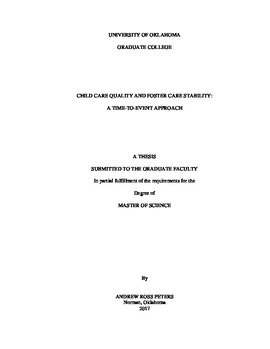| dc.description.abstract | Early Childcare and Education (ECE) frequently serve as the focus of efforts to improve the well-being of children in foster homes. This study uses archival data to explore the effects of ECE subsidy use, ECE type, and ECE quality on hazard models predicting foster-care disruption. We gathered data from the Oklahoma Department of Human Services (OKDHS) on foster placements, subsidized ECE use, the type of ECE (home versus childcare), and the quality of the child care (as measured by the OKDHS ‘Reaching for the Stars’ Quality Rating system). We fit a series of mixed-effects time-to-event models predicting foster disruption using ECE use, type, and quality. We found that ECE use decreased Hazard for all conditions, but the protective effect seemed to decrease with time. Quality Certification level did not have a uniform association with the rate of disruption, but higher qualities may last longer. Home-based care may also retain a protective effect over a longer period of time, depending on quality. | en_US |
